Designs of the Rundgang-Design-Competition 2020
The Rundgang – Open Days of the Berlin University of the Arts is a firmly established event in Berlin's cultural summer. At the end of the academic year Germany's largest art university with its four colleges, the Berlin Career College and the Inter-University Centre for Dance opens its workshops, studios and rehearsal rooms for the public thus creating an opportunity to get in contact with our artists and their works.
Every year in February we start the design competition in one of the four design classes and give students the chance to show there vision of the University.
Due to the pandemic, the Rundgang 2020 had to be cancelled in March. However, the competition to find the circuit design was already held in February in the illustration class of Prof. Henning Wagenbreth with the jury's decision. Since we want to honour the work of the winner Anton Ohlow, we decided to use his design for the Rundgang - Open Days of the Berlin University of the Arts 2021.
We are pleased to present here the designs that were created in 2020.
Platz 1: Anton Ohlow

[Translate to English:] Pilze sind etwas ganz Besonderes. Es gibt viele verschiedene Sorten in allen Formen und Farben. Einige kann man essen, andere sind giftig, und manche sind sogar bewusstseinserweiternd. Pilze wachsen nicht überall - je nach Boden, Schatten oder Feuchtigkeit. Das, was wir als Pilz kennen, ist aber nur der Fruchtkörper. Hautsächlich besteht der Pilz aus einem unterirdischen Netzwerk aus Zellen, dem Myzel, welches das ganze Jahr über im Boden ist, Nährstoffe aus der Umgebung zieht und sogar mit seiner Umwelt kommunizieren kann. Nur einmal im Jahr wächst aus diesem der Fruchtkörper hervor. Die Universität der Künste Berlin ist wie ein Pilz. Sie gedeiht unter bestimmten Voraussetzungen, sie kommuniziert und vernetzt sich – oft unmerklich - mit der Stadt. Einmal im Jahr bildet sie einen sichtbaren Fruchtkörper: den Rundgang, mit dem Ziel, das Bewusstsein der Stadt zu erweitern.
source: Anton OhlowPlatz 2: Karen Exner - Kombination
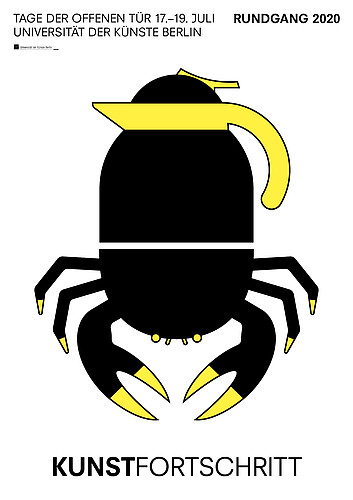
Meine sieben Plakate sind mit einem modularen System aus Bildern und Wörtern erstellt worden. Es stellt die Kunsthochschule als einen Ort da, wo die Dinge verwandelt, gedreht, kombiniert, vermischt und neu ausgehandelt werden. So entstehen neue ungewöhnliche Dinge, Wege, Bedeutungen und Lösungen. Am Rundgang zeigen wir unsere so entstandenen Werke. Alle Module können miteinander kombiniert und durchgetauscht werden. Denn die Arbeit an einer Kunsthochschule ist frei und ergebnisoffen, ein Experiment. Sie ist immer wieder veränderbar und flexibel. Die Bildmotive sollen die Vielfältigkeit der UdK Berlinwiderspiegeln: Mensch, Natur, Technik, Gestaltung, Kultur. Die Begriffe beziehen sich auf die Ziele und Werte der UdK Berlin als große interdisziplinäre Kunsthochschule.
source: Karen Exner
Meine sieben Plakate sind mit einem modularen System aus Bildern und Wörtern erstellt worden. Es stellt die Kunsthochschule als einen Ort da, wo die Dinge verwandelt, gedreht, kombiniert, vermischt und neu ausgehandelt werden. So entstehen neue ungewöhnliche Dinge, Wege, Bedeutungen und Lösungen. Am Rundgang zeigen wir unsere so entstandenen Werke. Alle Module können miteinander kombiniert und durchgetauscht werden. Denn die Arbeit an einer Kunsthochschule ist frei und ergebnisoffen, ein Experiment. Sie ist immer wieder veränderbar und flexibel. Die Bildmotive sollen die Vielfältigkeit der UdK Berlinwiderspiegeln: Mensch, Natur, Technik, Gestaltung, Kultur. Die Begriffe beziehen sich auf die Ziele und Werte der UdK Berlin als große interdisziplinäre Kunsthochschule.
source: Karen Exner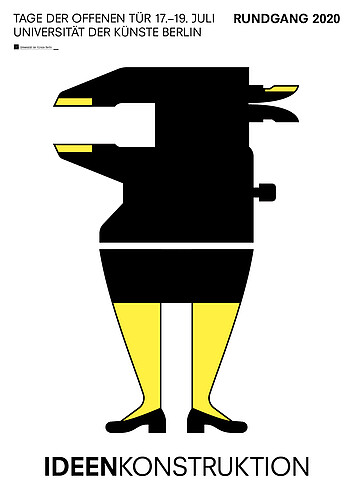
Meine sieben Plakate sind mit einem modularen System aus Bildern und Wörtern erstellt worden. Es stellt die Kunsthochschule als einen Ort da, wo die Dinge verwandelt, gedreht, kombiniert, vermischt und neu ausgehandelt werden. So entstehen neue ungewöhnliche Dinge, Wege, Bedeutungen und Lösungen. Am Rundgang zeigen wir unsere so entstandenen Werke. Alle Module können miteinander kombiniert und durchgetauscht werden. Denn die Arbeit an einer Kunsthochschule ist frei und ergebnisoffen, ein Experiment. Sie ist immer wieder veränderbar und flexibel. Die Bildmotive sollen die Vielfältigkeit der UdK Berlinwiderspiegeln: Mensch, Natur, Technik, Gestaltung, Kultur. Die Begriffe beziehen sich auf die Ziele und Werte der UdK Berlin als große interdisziplinäre Kunsthochschule.
source: Karen Exner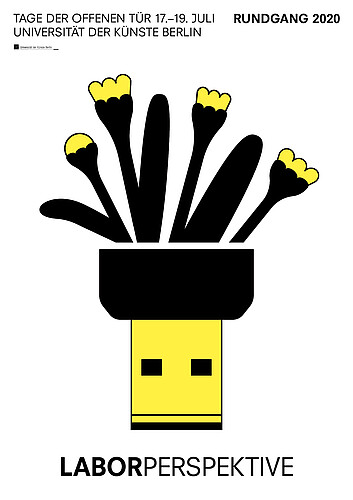
Meine sieben Plakate sind mit einem modularen System aus Bildern und Wörtern erstellt worden. Es stellt die Kunsthochschule als einen Ort da, wo die Dinge verwandelt, gedreht, kombiniert, vermischt und neu ausgehandelt werden. So entstehen neue ungewöhnliche Dinge, Wege, Bedeutungen und Lösungen. Am Rundgang zeigen wir unsere so entstandenen Werke. Alle Module können miteinander kombiniert und durchgetauscht werden. Denn die Arbeit an einer Kunsthochschule ist frei und ergebnisoffen, ein Experiment. Sie ist immer wieder veränderbar und flexibel. Die Bildmotive sollen die Vielfältigkeit der UdK Berlinwiderspiegeln: Mensch, Natur, Technik, Gestaltung, Kultur. Die Begriffe beziehen sich auf die Ziele und Werte der UdK Berlin als große interdisziplinäre Kunsthochschule.
source: Karen Exner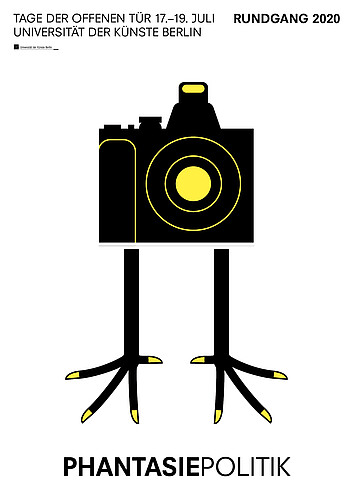
Meine sieben Plakate sind mit einem modularen System aus Bildern und Wörtern erstellt worden. Es stellt die Kunsthochschule als einen Ort da, wo die Dinge verwandelt, gedreht, kombiniert, vermischt und neu ausgehandelt werden. So entstehen neue ungewöhnliche Dinge, Wege, Bedeutungen und Lösungen. Am Rundgang zeigen wir unsere so entstandenen Werke. Alle Module können miteinander kombiniert und durchgetauscht werden. Denn die Arbeit an einer Kunsthochschule ist frei und ergebnisoffen, ein Experiment. Sie ist immer wieder veränderbar und flexibel. Die Bildmotive sollen die Vielfältigkeit der UdK Berlinwiderspiegeln: Mensch, Natur, Technik, Gestaltung, Kultur. Die Begriffe beziehen sich auf die Ziele und Werte der UdK Berlin als große interdisziplinäre Kunsthochschule.
source: Karen Exner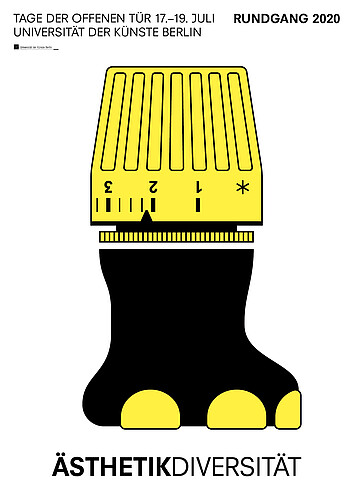
Meine sieben Plakate sind mit einem modularen System aus Bildern und Wörtern erstellt worden. Es stellt die Kunsthochschule als einen Ort da, wo die Dinge verwandelt, gedreht, kombiniert, vermischt und neu ausgehandelt werden. So entstehen neue ungewöhnliche Dinge, Wege, Bedeutungen und Lösungen. Am Rundgang zeigen wir unsere so entstandenen Werke. Alle Module können miteinander kombiniert und durchgetauscht werden. Denn die Arbeit an einer Kunsthochschule ist frei und ergebnisoffen, ein Experiment. Sie ist immer wieder veränderbar und flexibel. Die Bildmotive sollen die Vielfältigkeit der UdK Berlinwiderspiegeln: Mensch, Natur, Technik, Gestaltung, Kultur. Die Begriffe beziehen sich auf die Ziele und Werte der UdK Berlin als große interdisziplinäre Kunsthochschule.
source: Karen Exner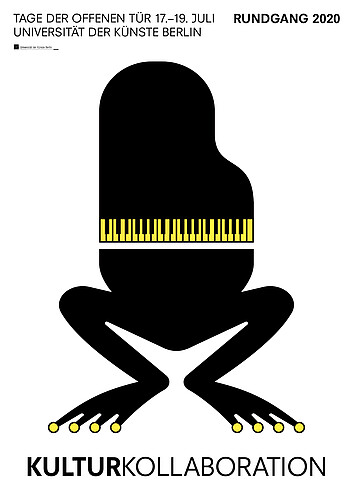
Meine sieben Plakate sind mit einem modularen System aus Bildern und Wörtern erstellt worden. Es stellt die Kunsthochschule als einen Ort da, wo die Dinge verwandelt, gedreht, kombiniert, vermischt und neu ausgehandelt werden. So entstehen neue ungewöhnliche Dinge, Wege, Bedeutungen und Lösungen. Am Rundgang zeigen wir unsere so entstandenen Werke. Alle Module können miteinander kombiniert und durchgetauscht werden. Denn die Arbeit an einer Kunsthochschule ist frei und ergebnisoffen, ein Experiment. Sie ist immer wieder veränderbar und flexibel. Die Bildmotive sollen die Vielfältigkeit der UdK Berlinwiderspiegeln: Mensch, Natur, Technik, Gestaltung, Kultur. Die Begriffe beziehen sich auf die Ziele und Werte der UdK Berlin als große interdisziplinäre Kunsthochschule.
source: Karen ExnerPlatz 3: Madeleine Brunnmeier - rrrrrundgang
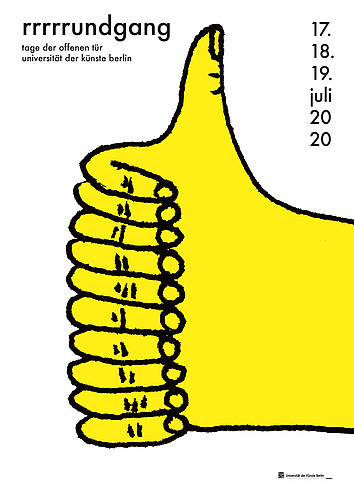
17. 18. 19. juli 2020? achtung! fertig? rrrrrundgang! mit einem breit grinsenden superlativ laden alle finger der universität der künste berlin ein, zu den alljährlichen tagen der offenen tür. unsere hände sind das, womit wir arbeiten, gestalten, begreifen, berühren und sprechen eine sprache, welche – wie die kunst – meist kulturübergreifend verständlich ist. ob wir übertreiben? finde es heraus!
source: Madeleine BrunnmeierPlatz 3: Dirk Kesseler - Feuer
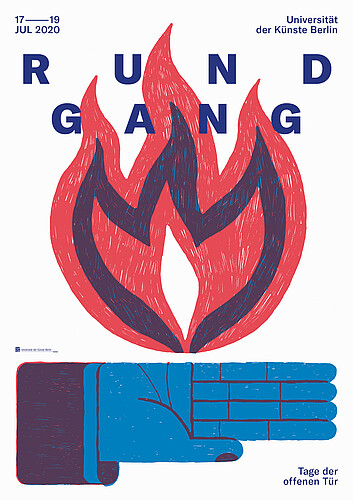
Das Feuer ist für den Menschen ein Symbol von Wissen, Lernen und Kreativität. Ein Lagerfeuer lädt zu einem gemeinschaftlichen Austausch ein. Feuer ist aber auch zerstörerisch. Wie wir es leider immer häufiger zu sehen bekommen. Im Prozess schafft es aber gleichzeitig Raum für neue Entwicklung. Die Asche ist die Grundlage für neue Ökosysteme. Die schwebende Flamme über der Handfläche wirkt auf den ersten Blick enigmatisch, dient aber als Einladung an unser Lagerfeuer an der Universität der Künste.
source: Dirk KesselerNiklas Apfel - Flappflapp
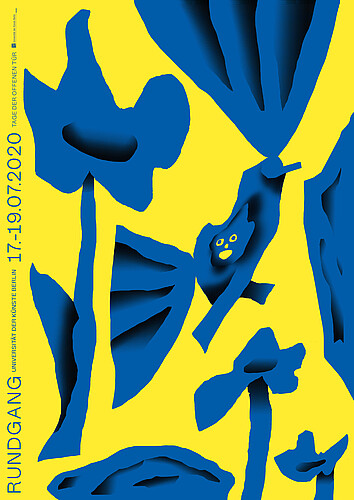
The abstract forms invite the poster to be read individually. The scope for interpretation is great. Everyone sees his or her own tour poster, just as the university represents an individual space for everyone.
source: Niklas Apfel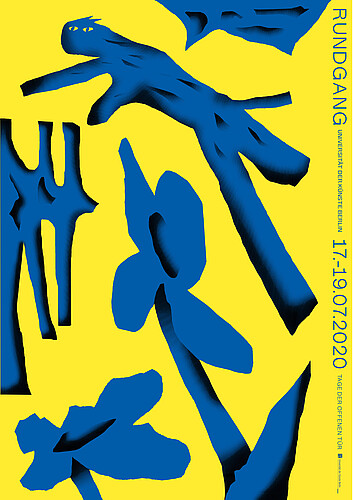
The abstract forms invite the poster to be read individually. The scope for interpretation is great. Everyone sees his or her own tour poster, just as the university represents an individual space for everyone.
source: Niklas ApfelLuise Schaller - Ideenfabrik
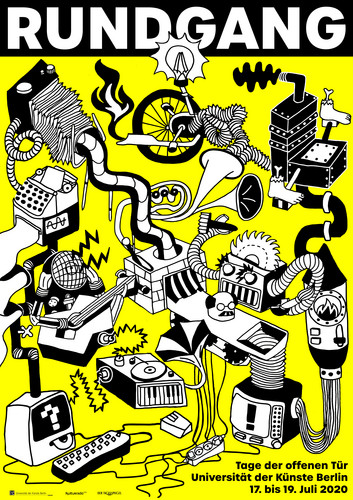
A factory is a multifaceted place, consisting of numerous components, each of which has its own individual importance and forms a functioning unit through productive cooperation. Thus it has much in common with the UdK Berlin. There too, there is a great diversity of individual students, lecturers and faculties, each with their own wealth of ideas. In addition to this, the motif of the factory reflects well the productivity and the working process of projects and emphasizes the importance of experimentation. Most importantly, the many different parts of the factory also draw attention to the appreciation of different approaches to art or creative work. This is what makes the UdK Berlin with its many locations and faculties so special.
source: Luise SchallerOle Paland
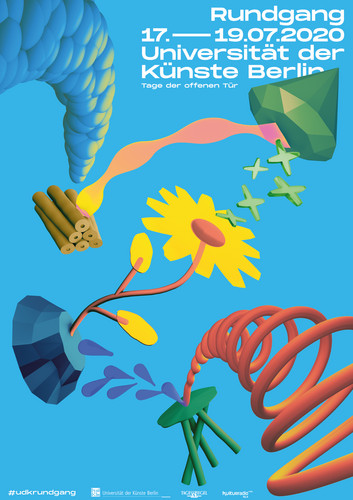
Marlene Krause
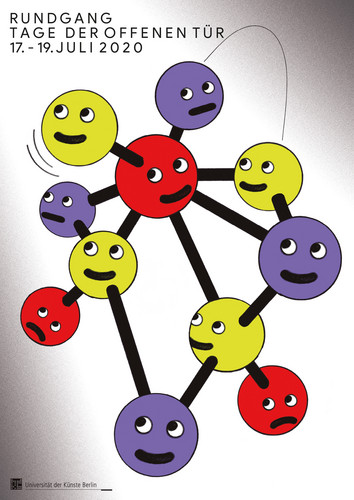
Anastasia Hafermaas – Panther
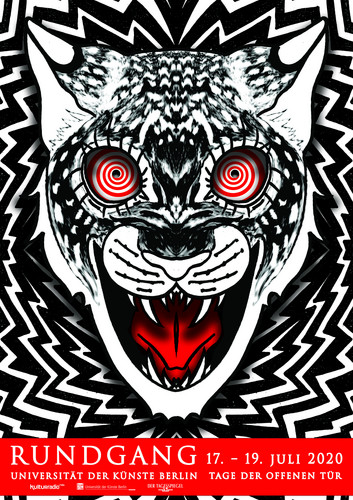
Lina Wimmer - Fallen
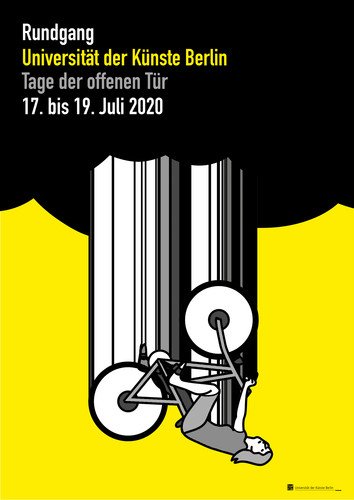
Artists are often assumed to live in their own bubble, even in their own world, to build castles in the air and to have their heads in the clouds. But these are exactly the precious and wonderful privileges and values that make such a special place. A place where you can experiment, dream and have your head in the clouds. These associations, as well as "no master has fallen from the sky yet" and "falling out of all clouds" are taken up in the poster series. The UdK Berlin Rundgang itself can be seen as an interface or reality check, where the doors are opened to the general public.
source: Lina Wimmer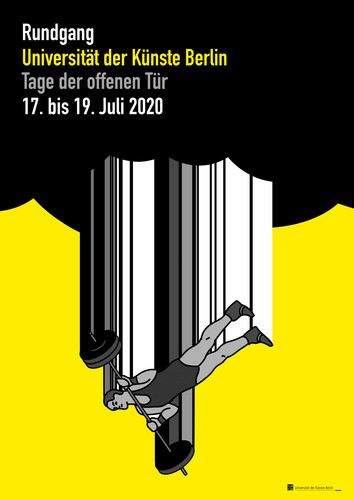
Artists are often assumed to live in their own bubble, even in their own world, to build castles in the air and to have their heads in the clouds. But these are exactly the precious and wonderful privileges and values that make such a special place. A place where you can experiment, dream and have your head in the clouds. These associations, as well as "no master has fallen from the sky yet" and "falling out of all clouds" are taken up in the poster series. The UdK Berlin Rundgang itself can be seen as an interface or reality check, where the doors are opened to the general public.
source: Lina Wimmer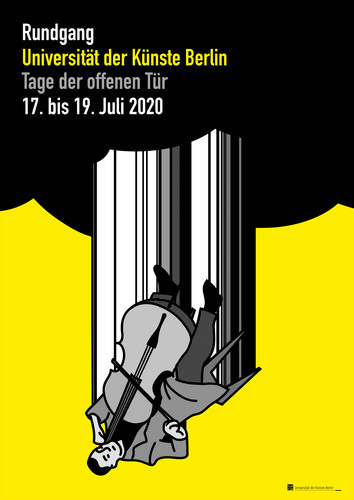
Artists are often assumed to live in their own bubble, even in their own world, to build castles in the air and to have their heads in the clouds. But these are exactly the precious and wonderful privileges and values that make such a special place. A place where you can experiment, dream and have your head in the clouds. These associations, as well as "no master has fallen from the sky yet" and "falling out of all clouds" are taken up in the poster series. The UdK Berlin Rundgang itself can be seen as an interface or reality check, where the doors are opened to the general public.
source: Lina WimmerYves Haltner – Kunst hilft
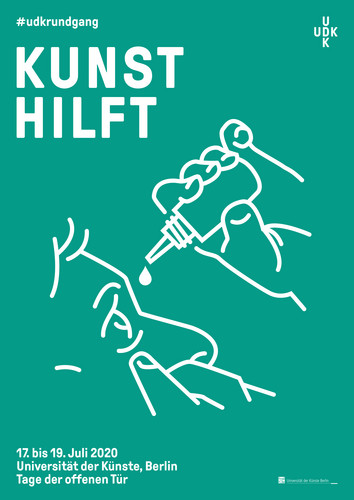
Every day you see, hear and say a lot and if you are not careful, your own sensory organs will quickly become blocked by all the information. That is why it is important to cleanse your senses at least once a year, just like changing the oil in a car. The annual Rundgang - Open Days of the Berlin University of the Arts is a good opportunity to confront yourself with something new and open your senses to alternative views and ways of thinking.
source: Yves Haltner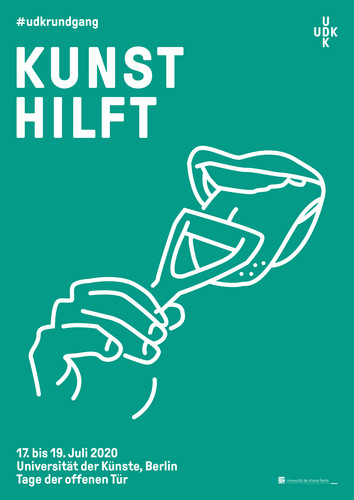
Every day you see, hear and say a lot and if you are not careful, your own sensory organs will quickly become blocked by all the information. That is why it is important to cleanse your senses at least once a year, just like changing the oil in a car. The annual Rundgang - Open Days of the Berlin University of the Arts is a good opportunity to confront yourself with something new and open your senses to alternative views and ways of thinking.
source: Yves Haltner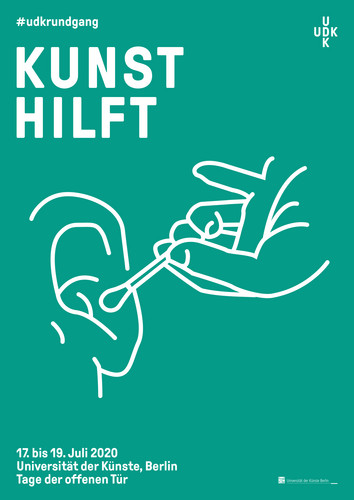
Every day you see, hear and say a lot and if you are not careful, your own sensory organs will quickly become blocked by all the information. That is why it is important to cleanse your senses at least once a year, just like changing the oil in a car. The annual Rundgang - Open Days of the Berlin University of the Arts is a good opportunity to confront yourself with something new and open your senses to alternative views and ways of thinking.
source: Yves HaltnerMattis Bettels – Reaktion
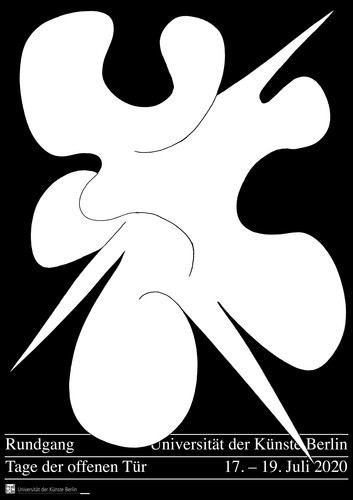
During the Rundgang - Open Days, a wide variety of people come together. It is the basis for exchange and discussion, which can also degenerate into disputes. Dispute does not necessarily mean bad, but can create something new and bring the parties involved further. Two forms symbolize this meeting and the resulting reaction for which the tour is the breeding ground.
source: Mattis Bettels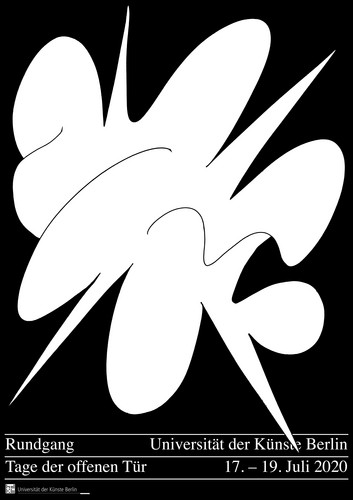
During the Rundgang - Open Days, a wide variety of people come together. It is the basis for exchange and discussion, which can also degenerate into disputes. Dispute does not necessarily mean bad, but can create something new and bring the parties involved further. Two forms symbolize this meeting and the resulting reaction for which the tour is the breeding ground.
source: Mattis BettelsNatasa Jovanic - Connection
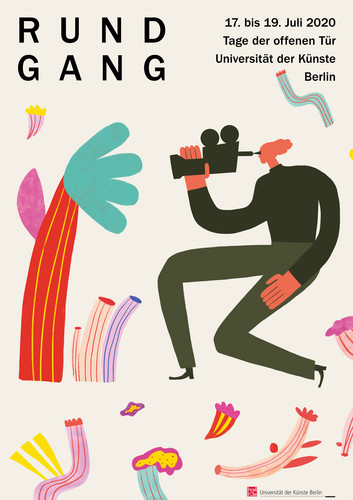
Nature grows, develops and changes constantly. It reflects the current state of the society and human mind, just like the art. We are there to establish communication and to follow the changes that are happening in this field. Whether it is an environment full of plants or completely rocky, we should find the way to participate in its growth and transformation. The aim is to follow up every transformation that the new UdK Rundgang brings.
source: Natasa Jovanic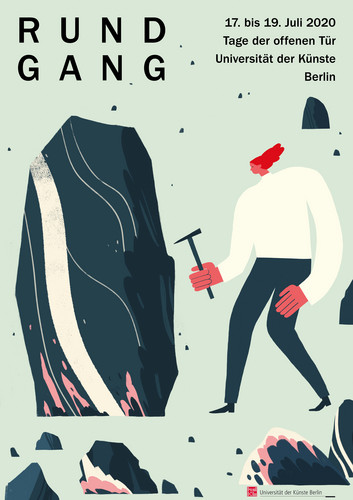
Nature grows, develops and changes constantly. It reflects the current state of the society and human mind, just like the art. We are there to establish communication and to follow the changes that are happening in this field. Whether it is an environment full of plants or completely rocky, we should find the way to participate in its growth and transformation. The aim is to follow up every transformation that the new UdK Rundgang brings.
source: Natasa JovanicLaura Stoppkotte – Bug in the System
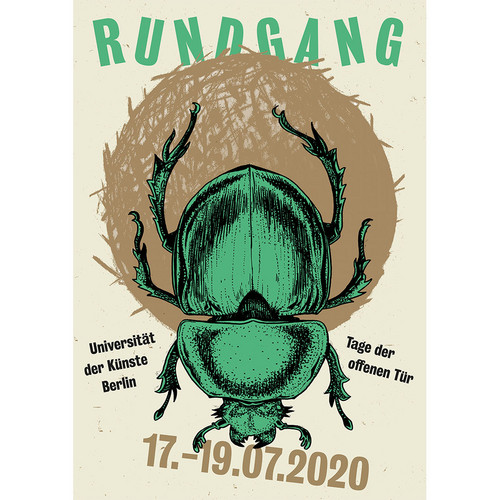
The dung beetle is also called the pill turner, because it rolls its food, which consists mainly of animal excrement, in a ball in front of it for a lifetime and also lays its eggs in it. Art students are like dung beetles, who during their studies accumulate experience, inspiration, skills, knowledge, impressions and techniques in the hope that something fruitful will emerge. In ancient Egypt, the dung beetle, which they called a scarab, is revered as a symbol of creation, happiness and protection. One of the reasons for this is that it recognized early on when the Nile flood was coming and warned the villagers about the flood. It is also our task as artists to point out problems in our society.
source: Laura StoppkotteKonstantin Hildebrandt - Jump In
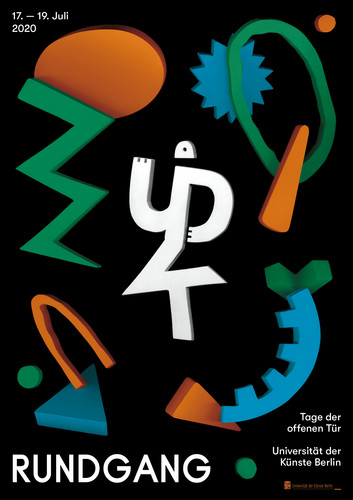
A new experience. The leap into the seemingly unknown. Exhibitors and visitors should meet during the Rundgang to face new ideas together. Understanding and respect are important in order to enter new spaces together and enrich the wealth of experience.
source: Konstantin HildebrandtSarah Böttcher - Partydog
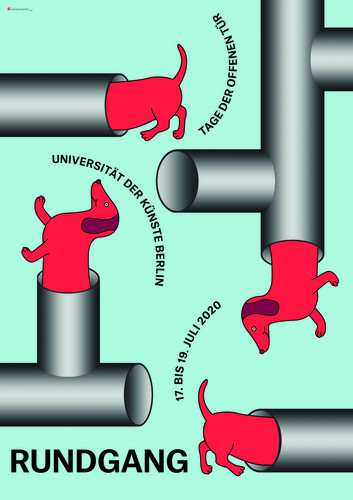
The dachshund is a hunting dog that hunts its prey from underground, confused and opaque building systems. Visitors to the Rundgang - Open Days also have to make their way through a system of different faculties, disciplines and impressions, repeatedly encountering dead ends and irritating turns.
source: Sarah Böttcher